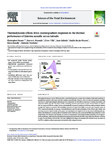Thermodynamic effects drive countergradient responses in the thermal performance of Littorina saxatilis across latitude
| dc.contributor.author | Dwane, C | |
| dc.contributor.author | Rezende, EL | |
| dc.contributor.author | Feistel, Susanne | |
| dc.contributor.author | Galindo, J | |
| dc.contributor.author | Rolán-Alvarez, E | |
| dc.contributor.author | Rundle, Simon | |
| dc.contributor.author | Truebano, M | |
| dc.date.accessioned | 2023-02-14T12:59:26Z | |
| dc.date.issued | 2023-03-10 | |
| dc.identifier.issn | 0048-9697 | |
| dc.identifier.issn | 1879-1026 | |
| dc.identifier.other | 160877 | |
| dc.identifier.uri | http://hdl.handle.net/10026.1/20360 | |
| dc.description.abstract |
Thermal performance curves (TPCs) provide a powerful framework to assess the evolution of thermal sensitivity in populations exposed to divergent selection regimes across latitude. However, there is a lack of consensus regarding the extent to which physiological adjustments that compensate for latitudinal temperature variation (metabolic cold adaptation; MCA) may alter the shape of TPCs, including potential repercussion on upper thermal limits. To address this, we compared TPCs for cardiac activity in latitudinally-separated populations of the intertidal periwinkle Littorina saxatilis. We applied a non-linear TPC modelling approach to explore how different metrics governing the shape of TPCs varied systematically in response to local adaptation and thermal acclimation. Both critical upper limits, and the temperatures at which cardiac performance was maximised, were higher in the northernmost (cold-adapted) population and displayed a countergradient latitudinal trend which was most pronounced following acclimation to low temperatures. We interpret this response as a knock-on consequence of increased standard metabolic rate in high latitude populations, indicating that physiological compensation associated with MCA may indirectly influence variation in upper thermal limits across latitude. Our study highlights the danger of assuming that variation in any one aspect of the TPC is adaptive without appropriate mechanistic and ecological context. | |
| dc.format.extent | 160877-160877 | |
| dc.format.medium | Print-Electronic | |
| dc.language | en | |
| dc.language.iso | eng | |
| dc.publisher | Elsevier BV | |
| dc.subject | Countergradient | |
| dc.subject | Latitudinal gradients | |
| dc.subject | Thermal performance curve | |
| dc.subject | Thermodynamic effects | |
| dc.subject | Metabolic cold adaptation | |
| dc.subject | Local adaptation | |
| dc.title | Thermodynamic effects drive countergradient responses in the thermal performance of Littorina saxatilis across latitude | |
| dc.type | journal-article | |
| dc.type | Journal Article | |
| plymouth.author-url | https://www.webofscience.com/api/gateway?GWVersion=2&SrcApp=PARTNER_APP&SrcAuth=LinksAMR&KeyUT=WOS:000911793300001&DestLinkType=FullRecord&DestApp=ALL_WOS&UsrCustomerID=11bb513d99f797142bcfeffcc58ea008 | |
| plymouth.volume | 863 | |
| plymouth.publication-status | Published | |
| plymouth.journal | Science of The Total Environment | |
| dc.identifier.doi | 10.1016/j.scitotenv.2022.160877 | |
| plymouth.organisational-group | /Plymouth | |
| plymouth.organisational-group | /Plymouth/Admin Group - REF | |
| plymouth.organisational-group | /Plymouth/Admin Group - REF/REF Admin Group - FoSE | |
| plymouth.organisational-group | /Plymouth/Faculty of Science and Engineering | |
| plymouth.organisational-group | /Plymouth/Faculty of Science and Engineering/School of Biological and Marine Sciences | |
| plymouth.organisational-group | /Plymouth/REF 2021 Researchers by UoA | |
| plymouth.organisational-group | /Plymouth/REF 2021 Researchers by UoA/UoA07 Earth Systems and Environmental Sciences | |
| plymouth.organisational-group | /Plymouth/Research Groups | |
| plymouth.organisational-group | /Plymouth/Research Groups/Marine Institute | |
| plymouth.organisational-group | /Plymouth/Users by role | |
| plymouth.organisational-group | /Plymouth/Users by role/Academics | |
| plymouth.organisational-group | /Plymouth/Users by role/Researchers in ResearchFish submission | |
| dc.publisher.place | Netherlands | |
| dcterms.dateAccepted | 2022-12-08 | |
| dc.rights.embargodate | 2023-2-15 | |
| dc.identifier.eissn | 1879-1026 | |
| dc.rights.embargoperiod | Not known | |
| rioxxterms.versionofrecord | 10.1016/j.scitotenv.2022.160877 | |
| rioxxterms.licenseref.uri | http://www.rioxx.net/licenses/all-rights-reserved | |
| rioxxterms.licenseref.startdate | 2023-03-10 | |
| rioxxterms.type | Journal Article/Review | |
| plymouth.funder | Developing an integrative approach to phenomics for industrial, biomedical and environmental applications::UK Research and Innovation |


